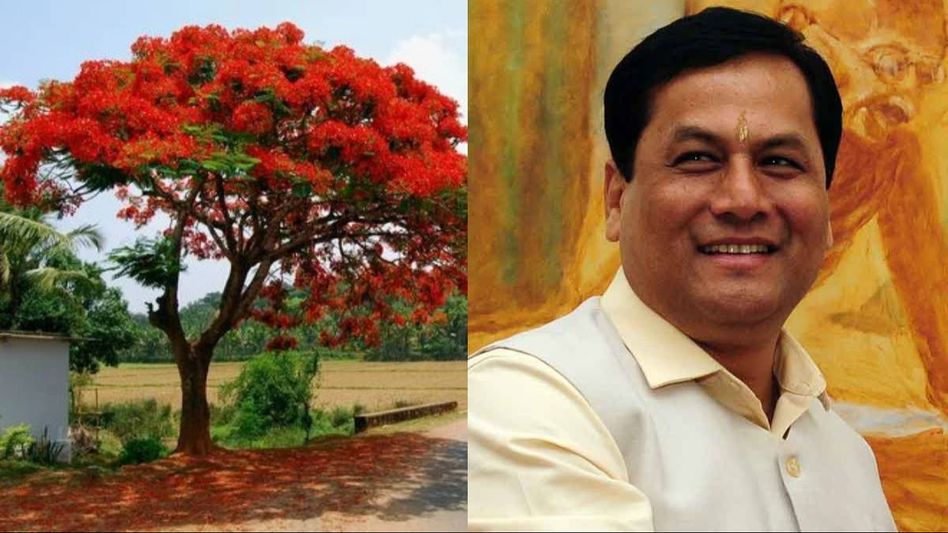Krishnachura: How Sarbananda Sonowal's sapling initiative is helping to beat the scorching heat
Krishnachura tree, celebrated for its vibrant flowers and lush leaves, has been planted in Kaliabor, Assam as part of a green initiative led by Sarbananda Sonowal. This effort underscores the community's commitment to environmental conservation.
 Krishnachura tree planted in Kaliabor, Assam as part of green initiative by Sarbananda Sonowal
Krishnachura tree planted in Kaliabor, Assam as part of green initiative by Sarbananda SonowalThe vibrant Krishnachura tree, scientifically known as Delonix regia, has captivated the hearts of many with its stunning display of fire-red crimson flowers and lush green foliage. Also known as Gulmohar, this member of the Fabaceae family is celebrated not only for its aesthetic appeal but also for its practical benefits, particularly its ability to provide much-needed shade during scorching heat.
In the town of Kaliabor, Assam, a special Krishnachura sapling planted by former Chief Minister Sarbananda Sonowal has drawn significant attention. This tree, part of a broader initiative launched during the 68th Vanmahotsav in 2017, aims to enhance the region's greenery and provide environmental benefits. The scheme involved the plantation of 28,000 saplings of various species, including Azar, Sonaru, Krishnachura, and Radhachura, along the national highway from Kaliabor to Bokakhat.
Botanical marvel and ecological benefit
Krishnachura is known for its vibrant red, orange, and yellow flowers that bloom in profusion, creating a spectacular visual feast. The tree's delicate, feathery leaves are bright green, providing a stark contrast to its vivid blossoms. The flowers have large petals, up to 8 cm long, with one petal typically featuring white or yellow markings, adding to the tree's charm.
Despite its striking beauty, Krishnachura is not just an ornamental tree. It plays a vital role in providing shade, which is especially valuable in regions experiencing intense heat. The tree's broad, spreading branches create a canopy that offers refuge from the sun, making it a popular choice for planting along roadsides and in public parks.
A global phenomenon
Originally found in the dry deciduous forests of Madagascar, Krishnachura has adapted well to various climates and is now grown in many parts of the world. While it is nearly extinct in the wild, its resilience and adaptability have made it a common sight in urban and suburban landscapes. In arid regions, Krishnachura is deciduous, shedding its leaves in summer. However, in temperate areas, it remains evergreen, contributing to its popularity as a shade tree.
Cultural and environmental significance
The plantation of Krishnachura in Assam, particularly the sapling nurtured in Kaliabor, underscores the cultural and environmental significance of this tree. Nature-loving individuals like Mrinal Bora have taken special care to ensure the sapling's growth, reflecting the community's commitment to environmental conservation.
Krishnachura's role extends beyond providing shade and beauty; it symbolizes resilience and the importance of green spaces in urban areas. Its ability to thrive in diverse conditions and its capacity to enhance the environment make it an invaluable addition to any landscape.
The Krishnachura tree, with its dazzling flowers and extensive canopy, is a testament to nature's beauty and utility. In regions like Assam, where the heat can be oppressive, this tree offers much-needed relief and aesthetic pleasure. The efforts of former Chief Minister Sarbananda Sonowal and the community in nurturing these trees highlight a collective dedication to enhancing the environment and combating the effects of climate change. As we continue to face global environmental challenges, the Krishnachura stands as a beacon of hope and a reminder of the power of nature in our lives.
Copyright©2025 Living Media India Limited. For reprint rights: Syndications Today









